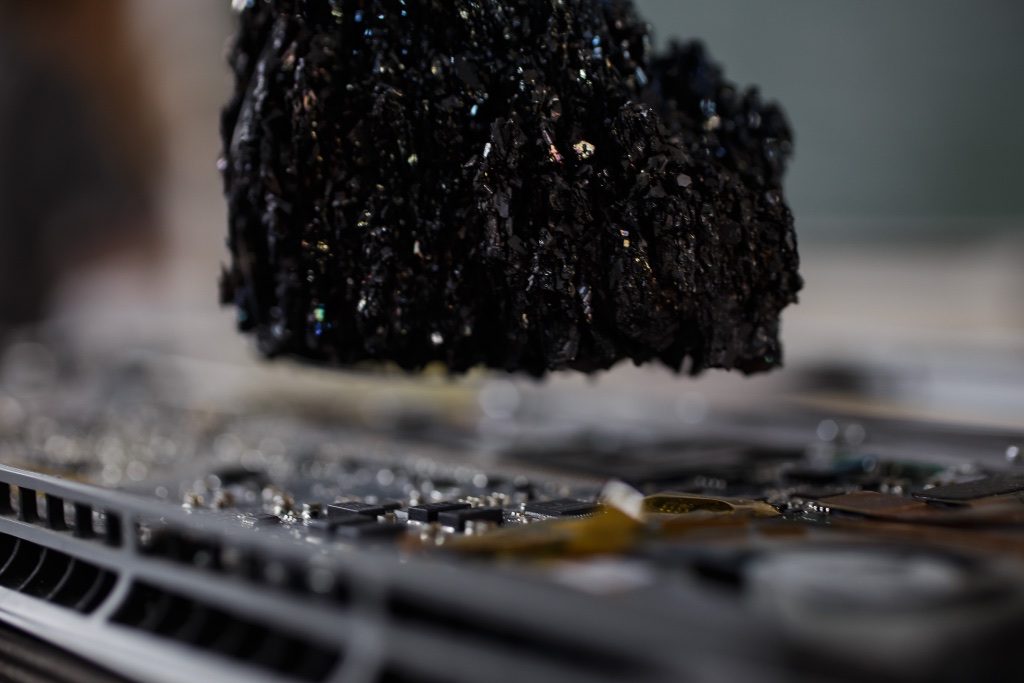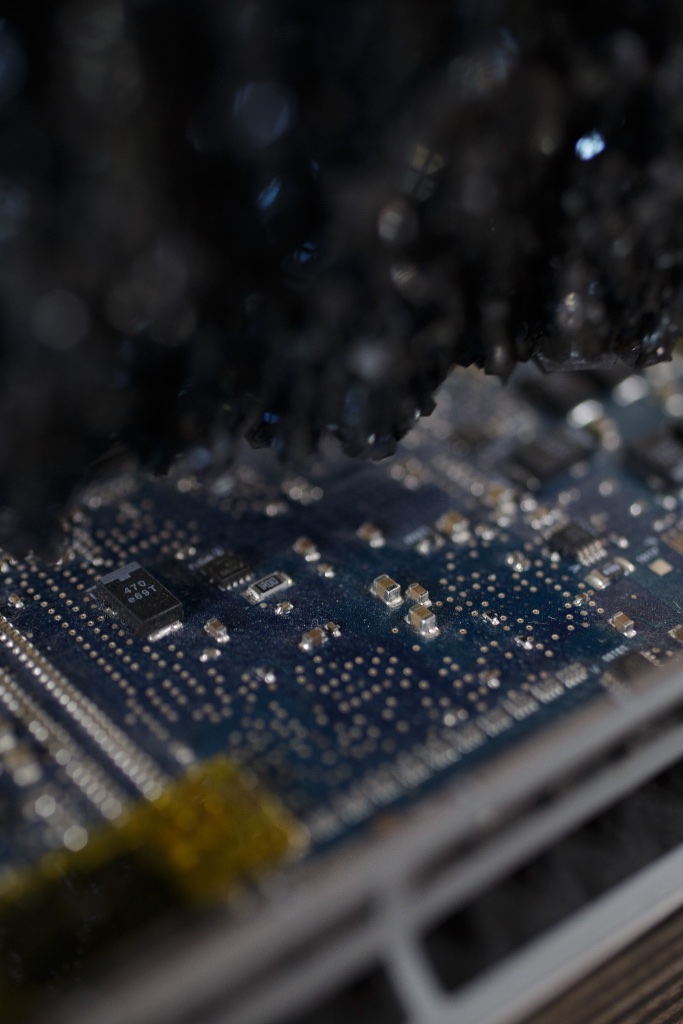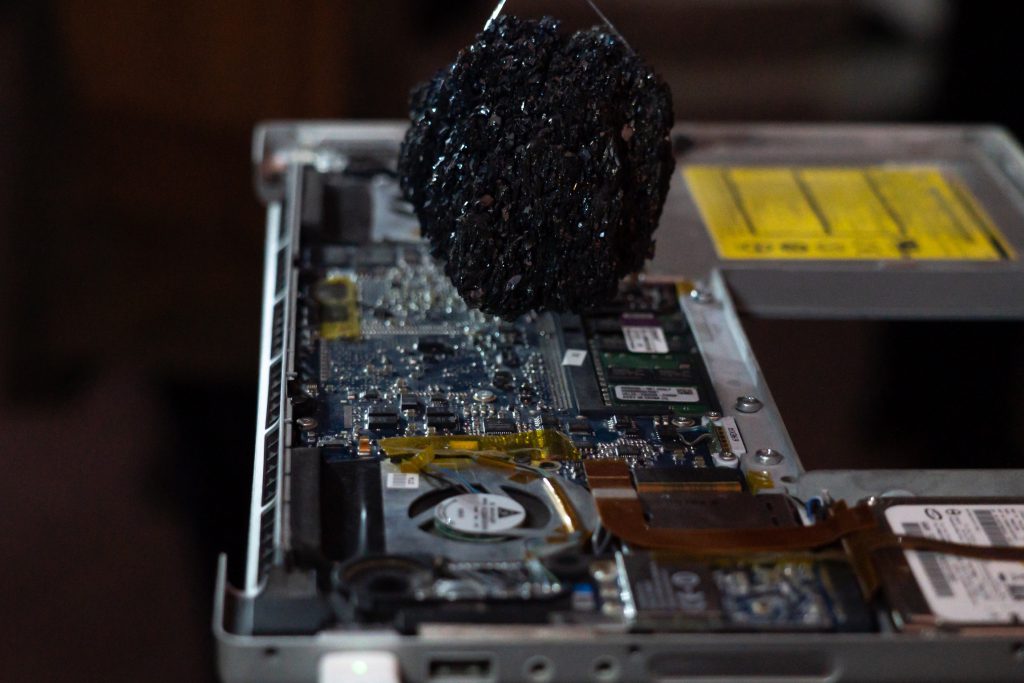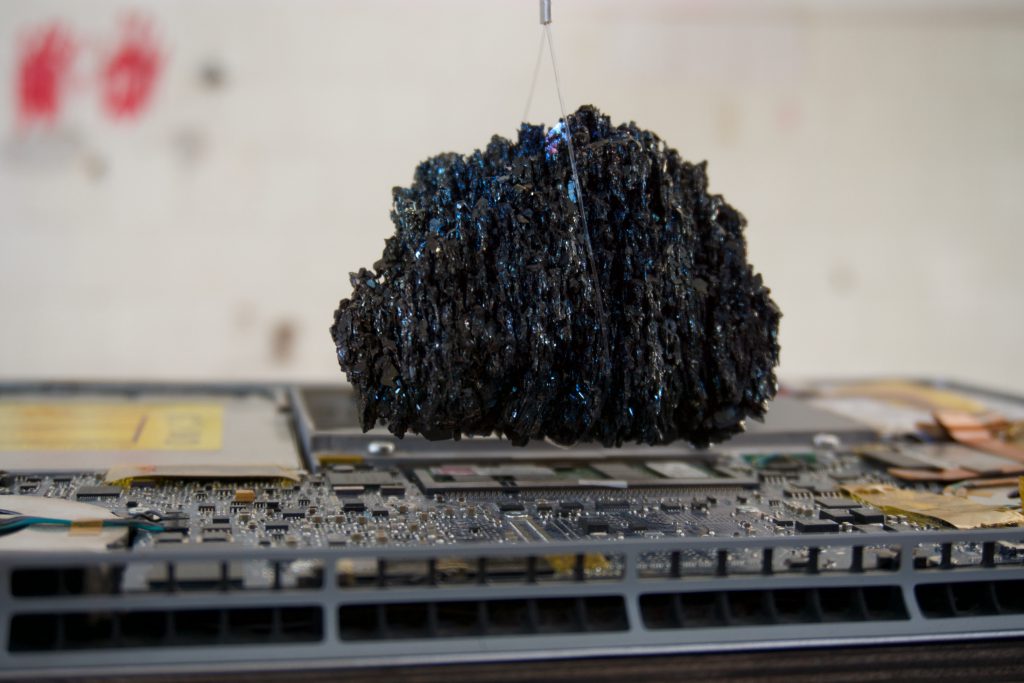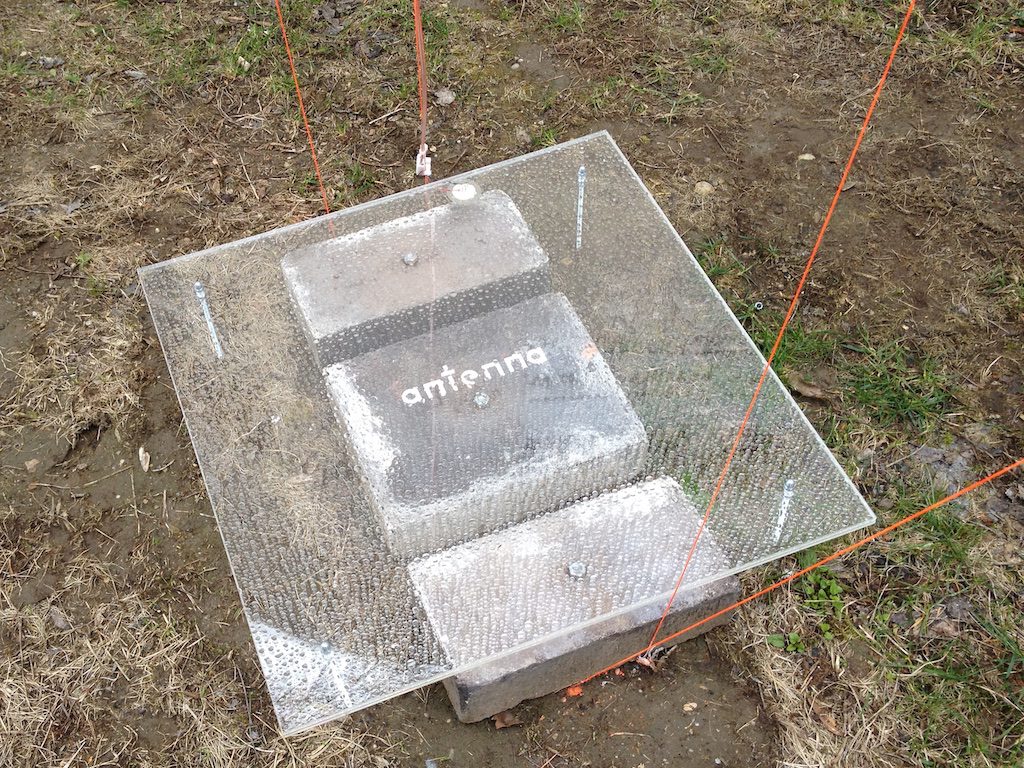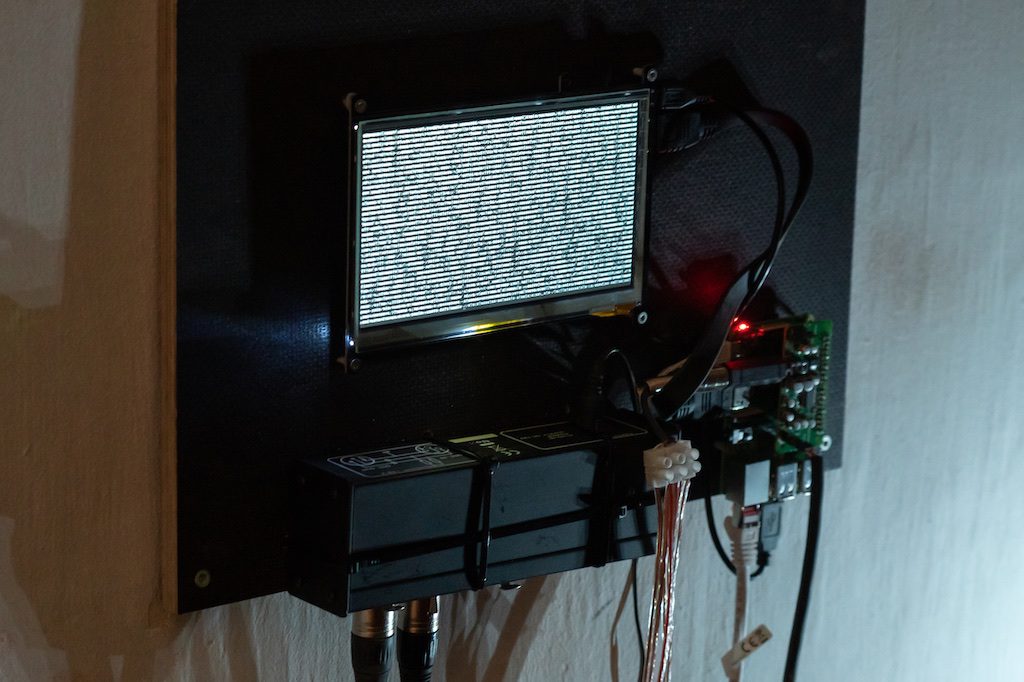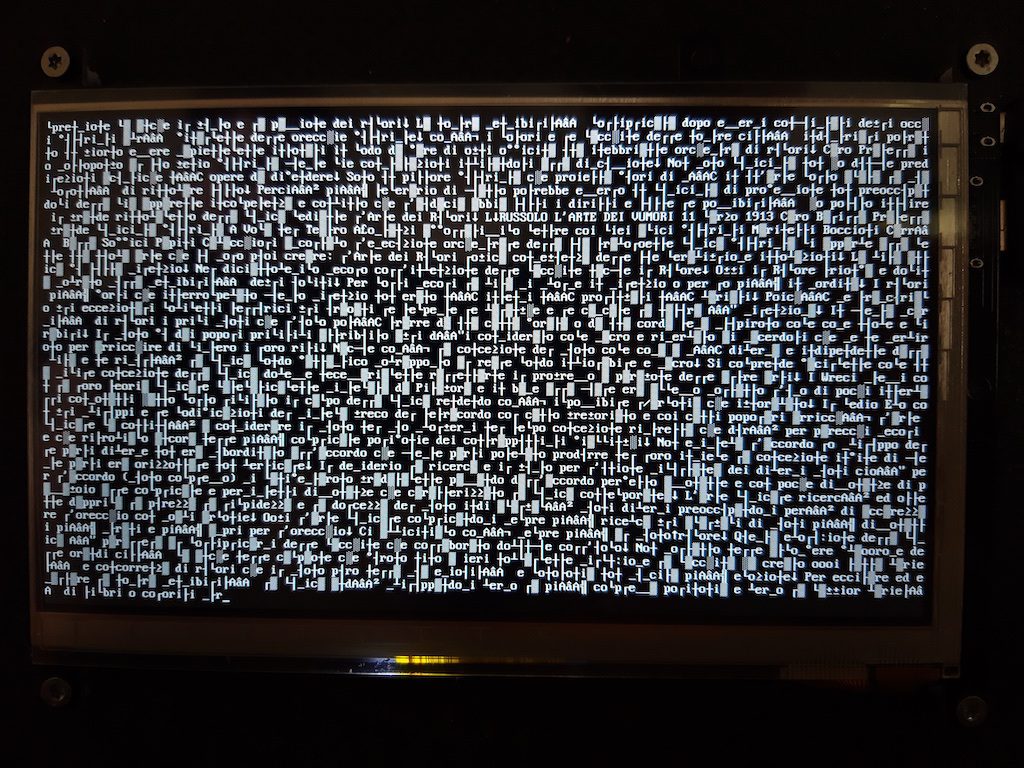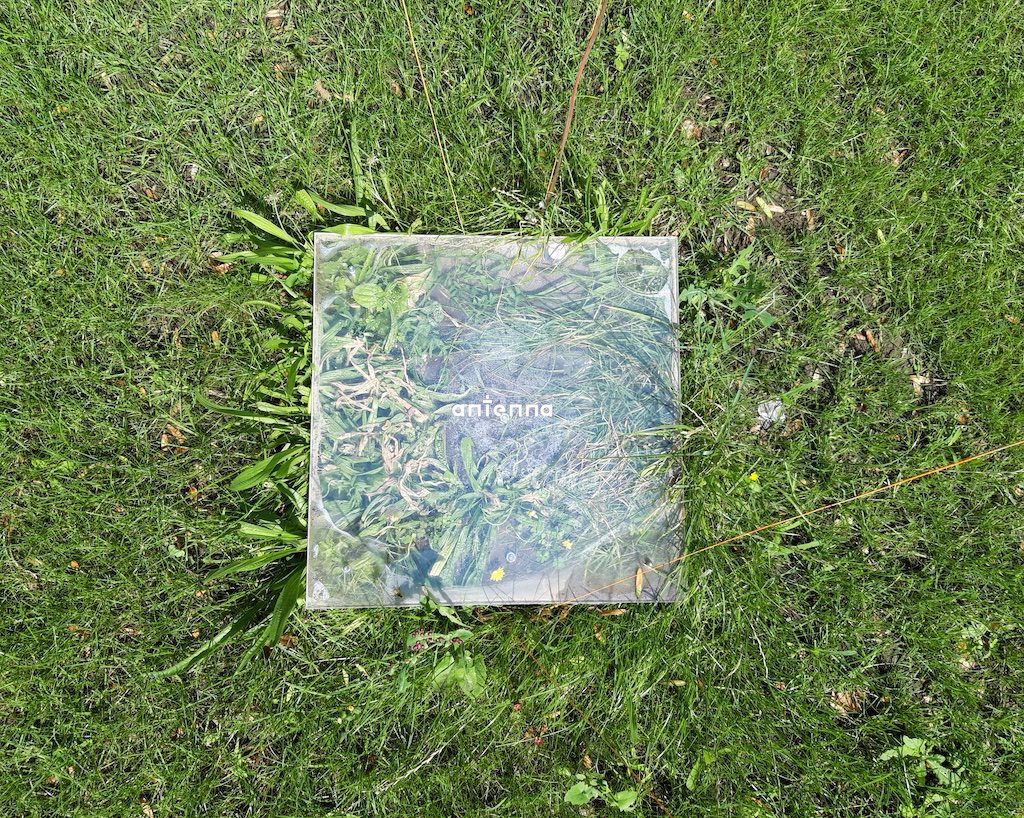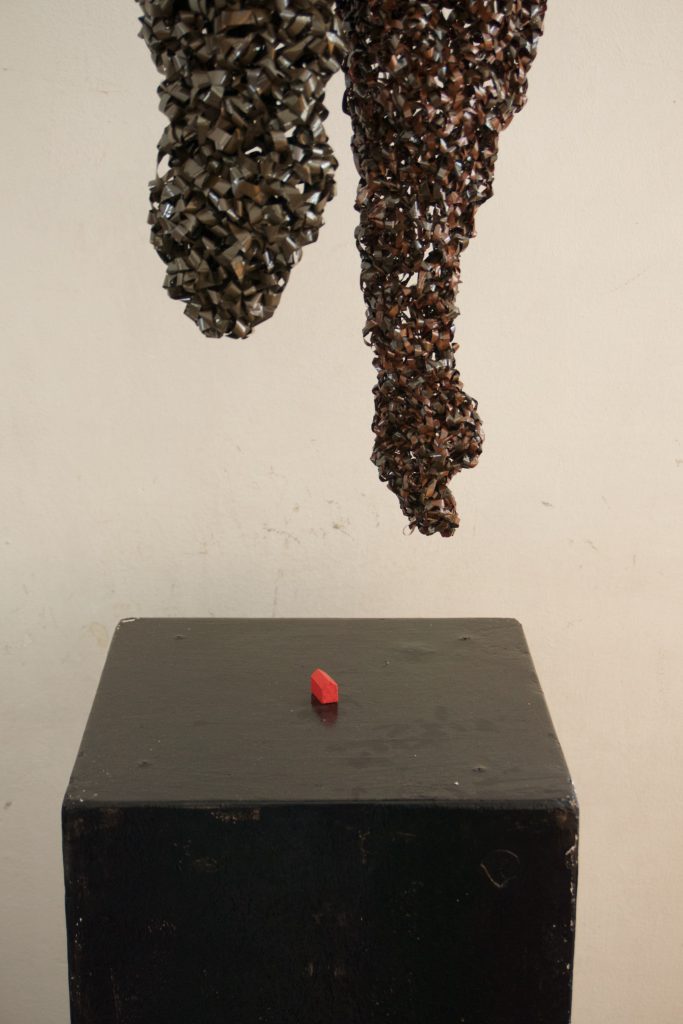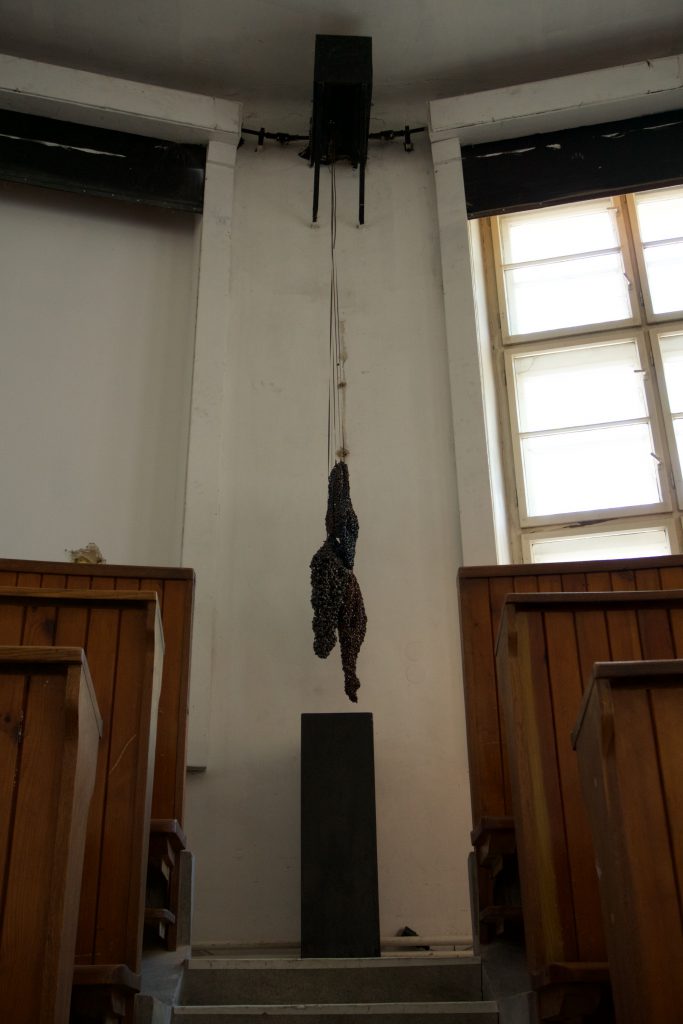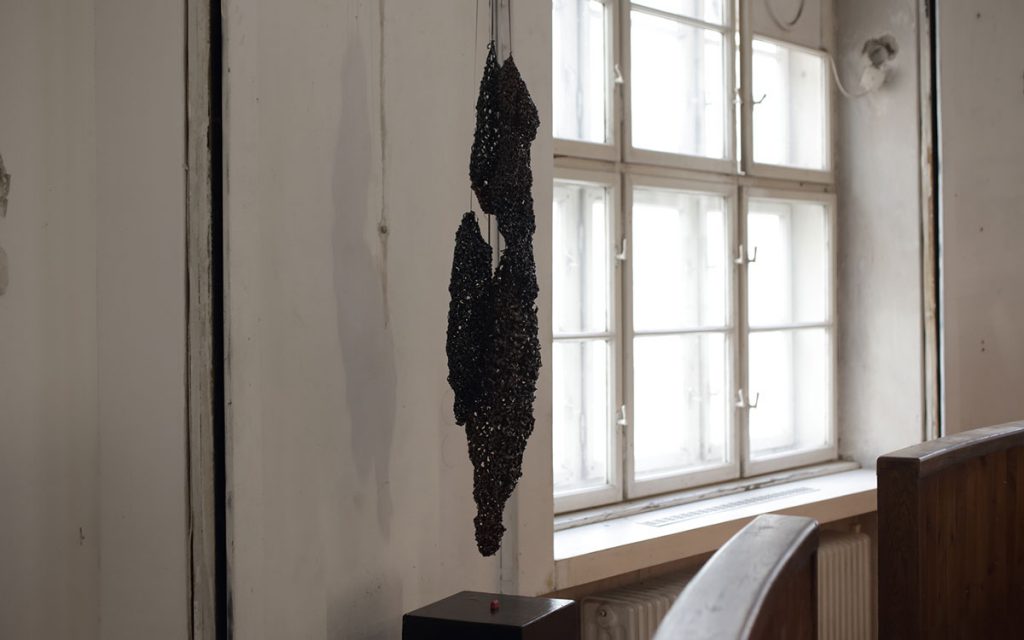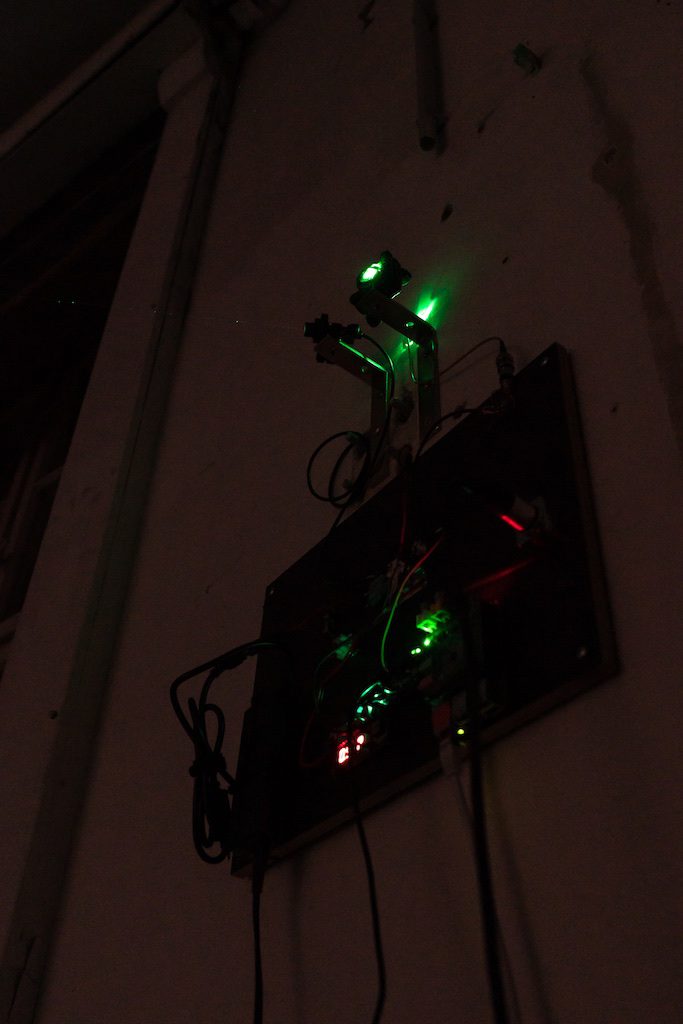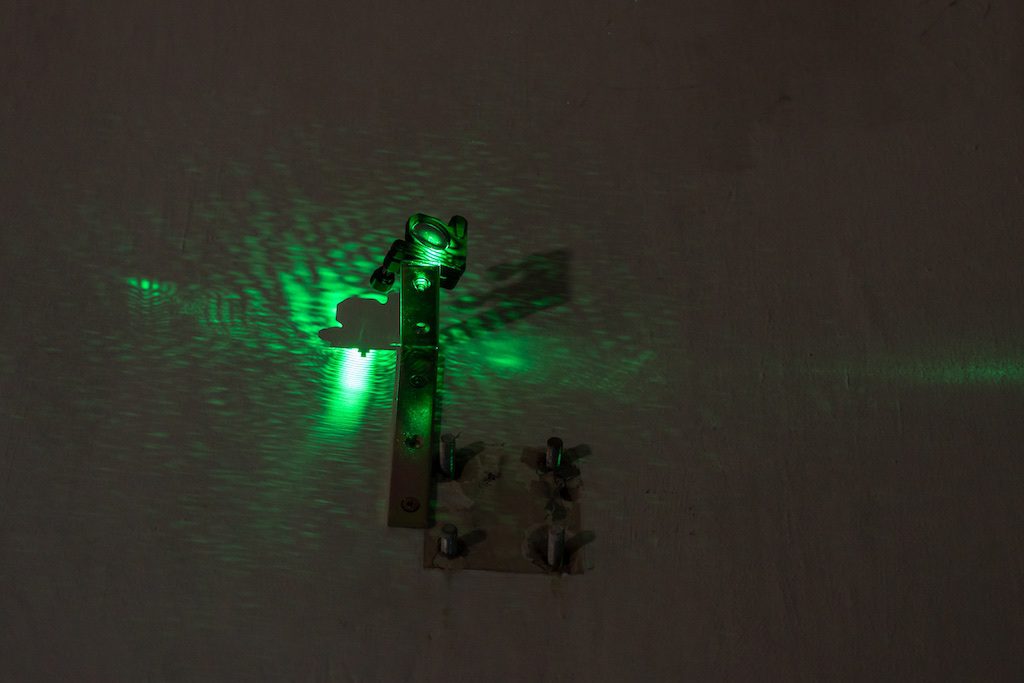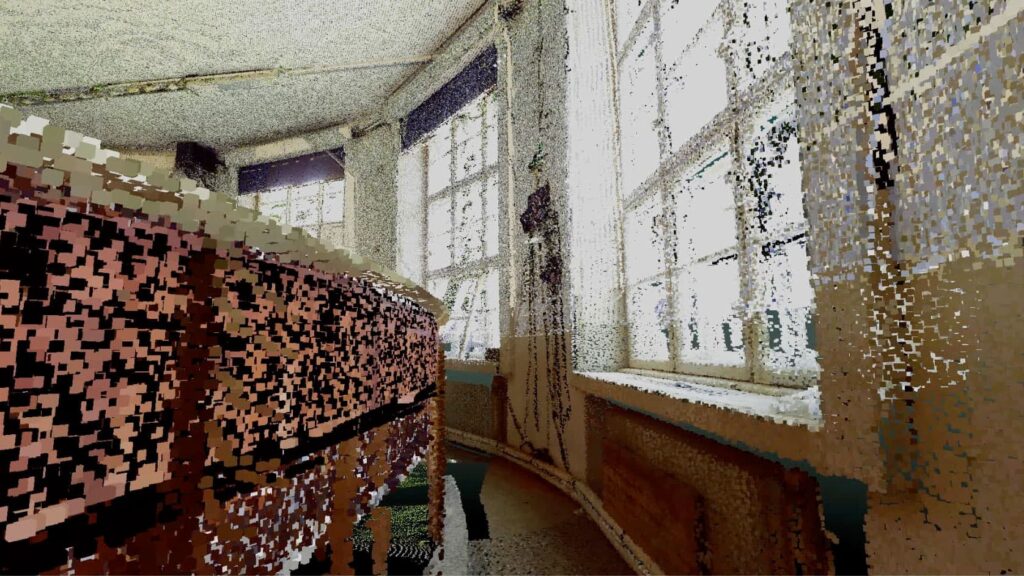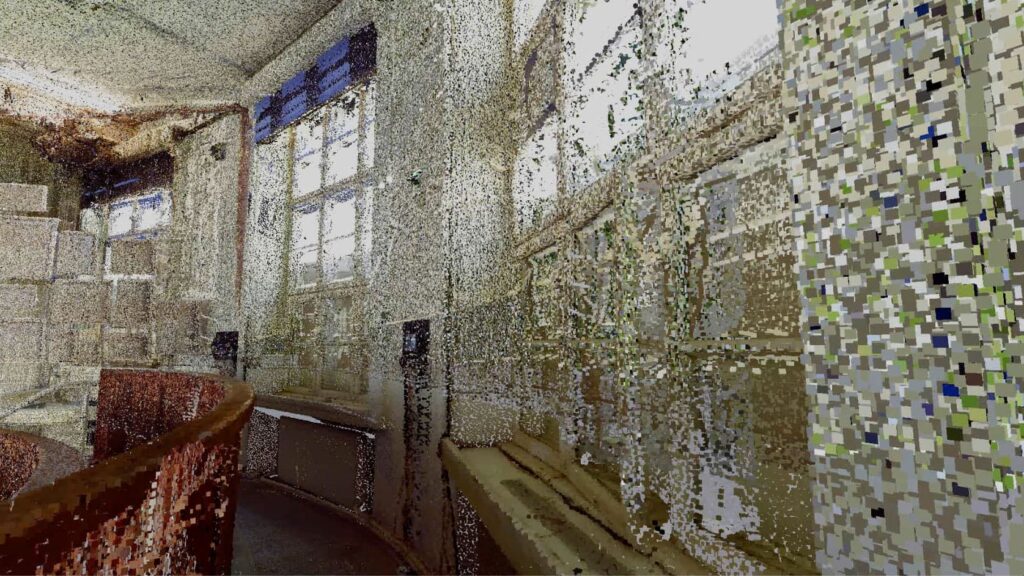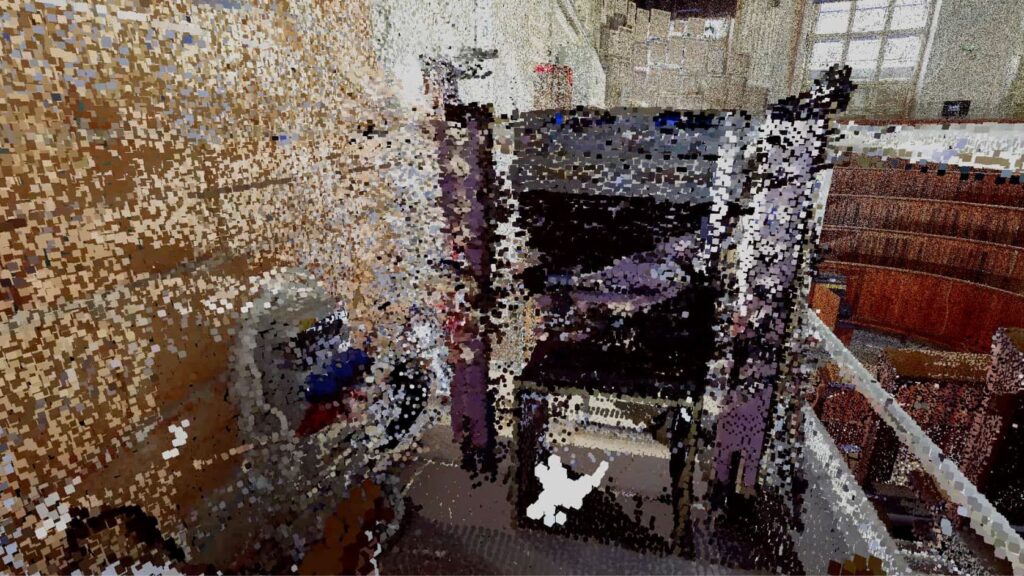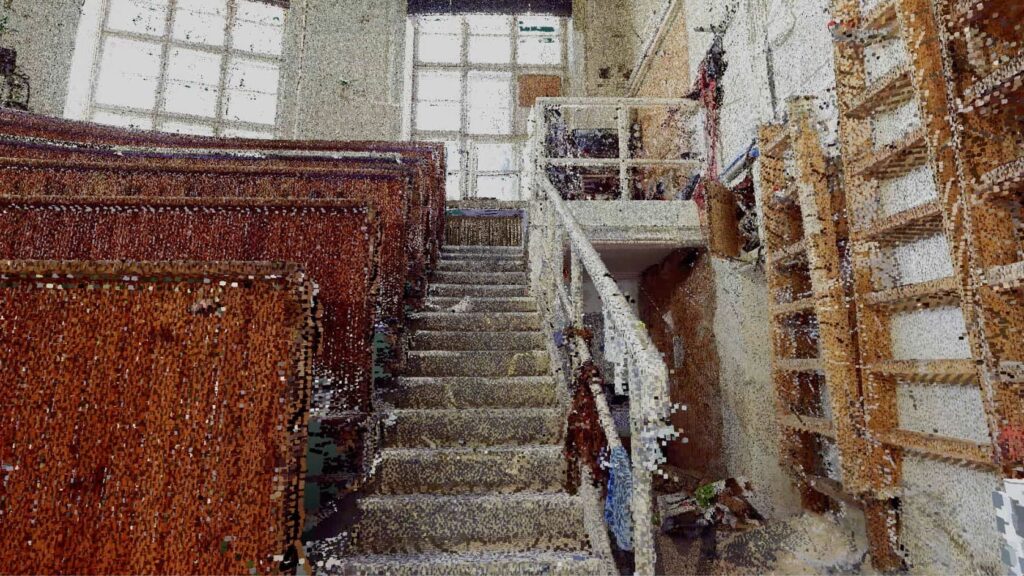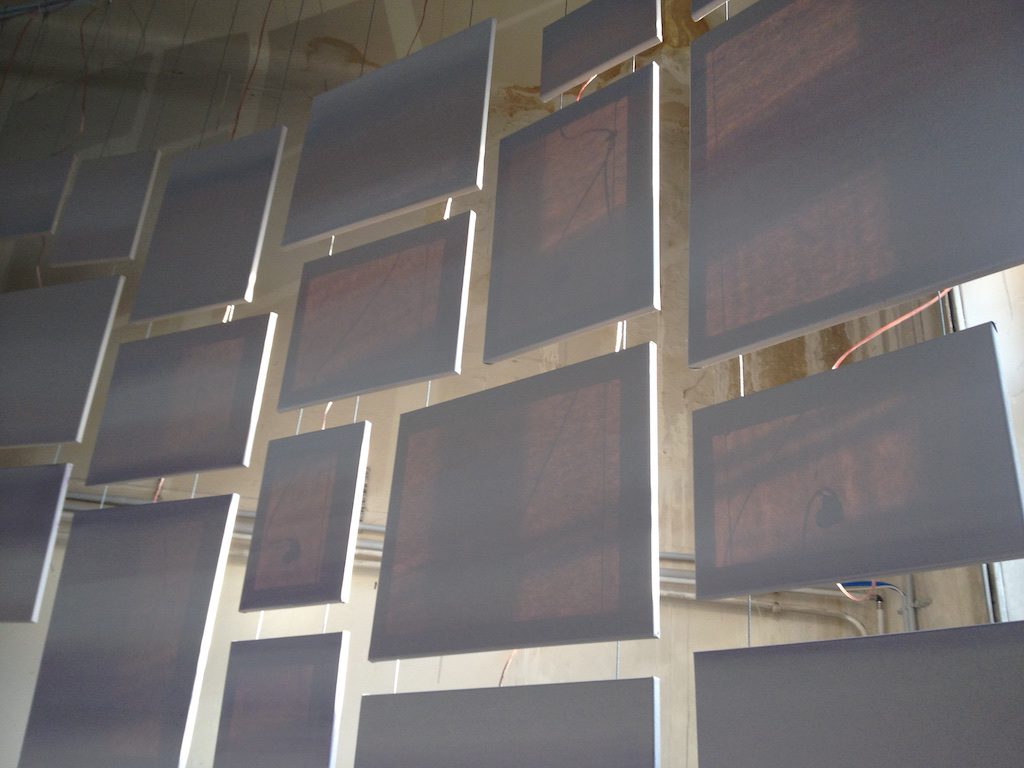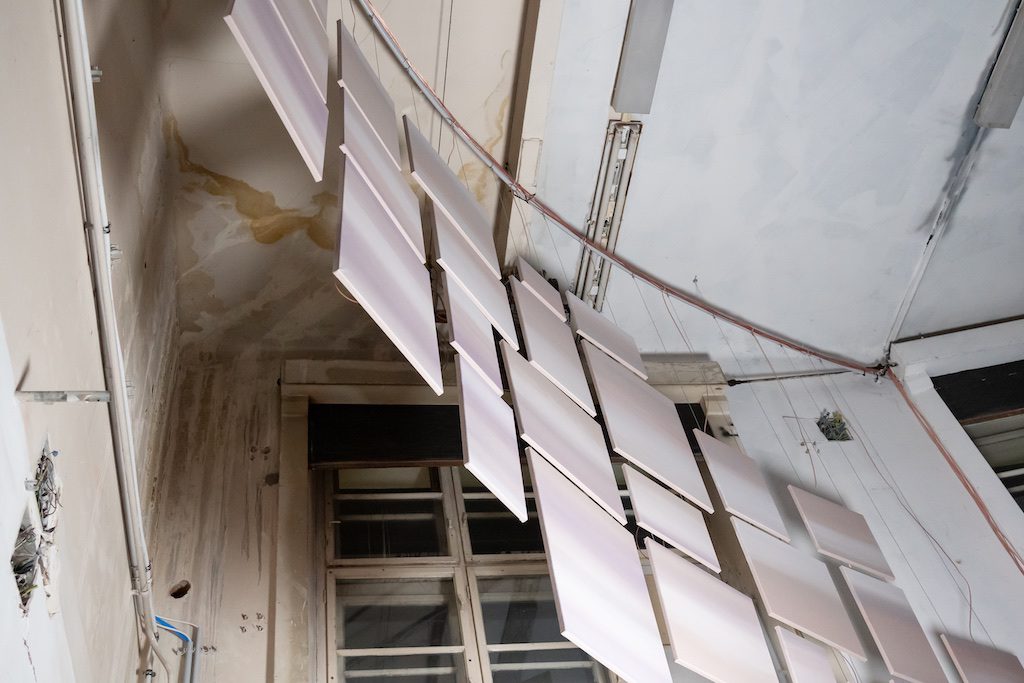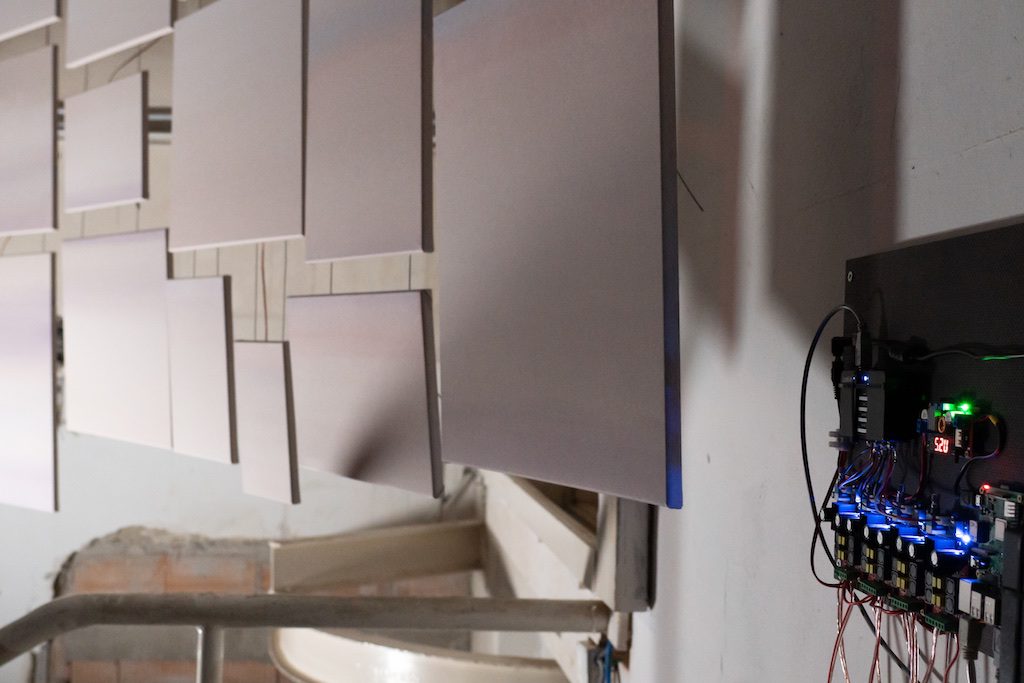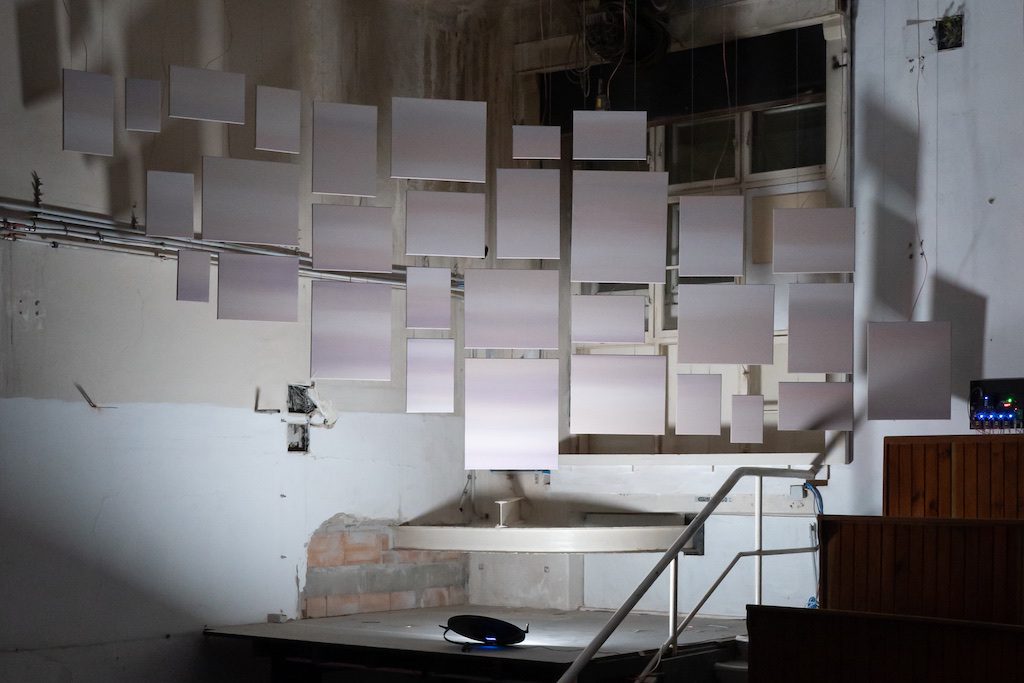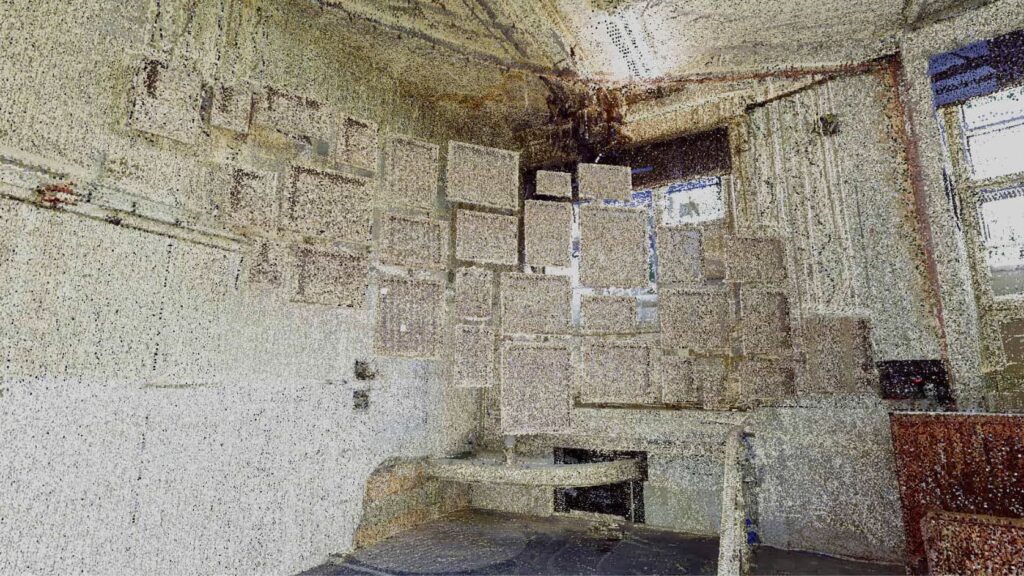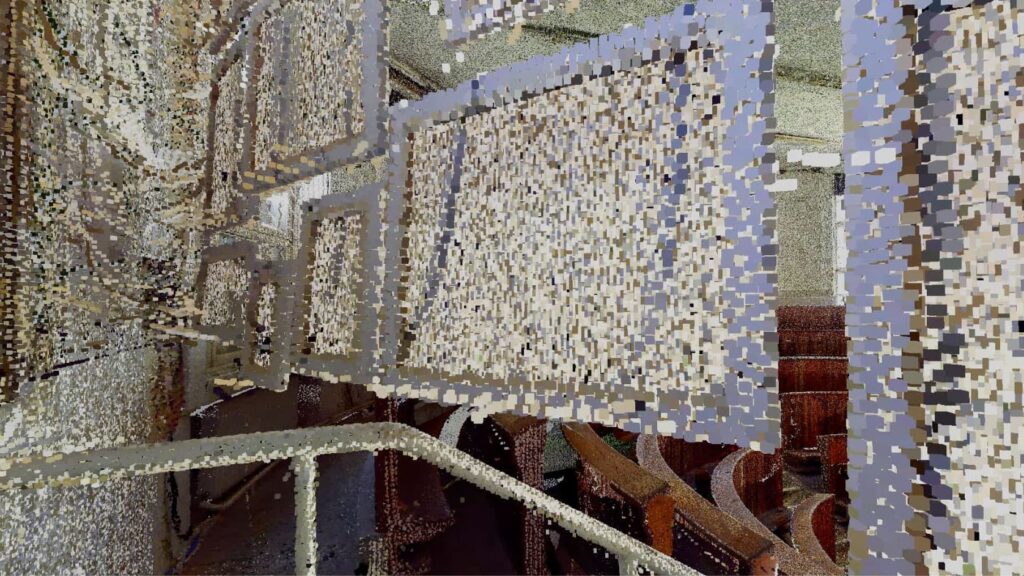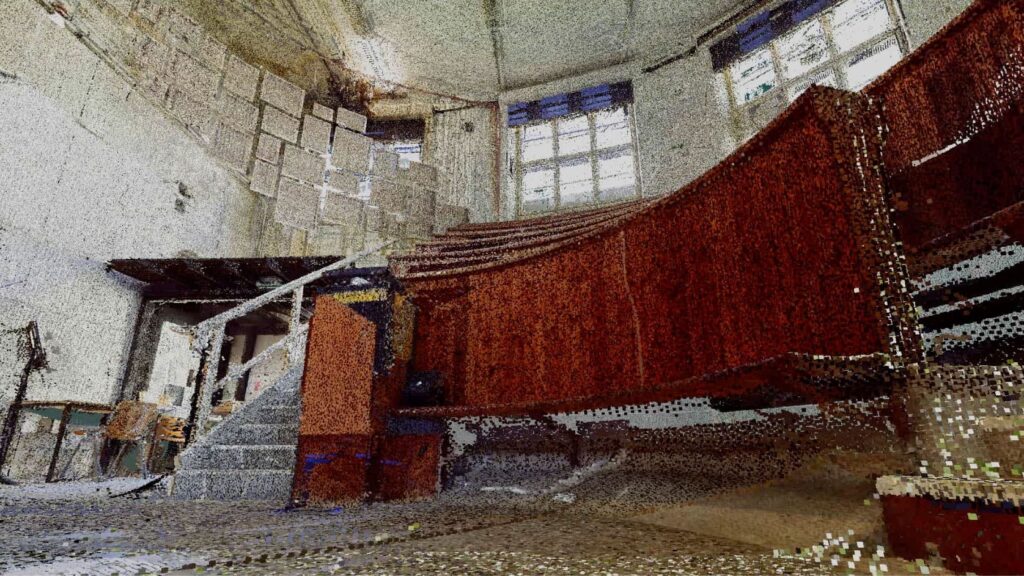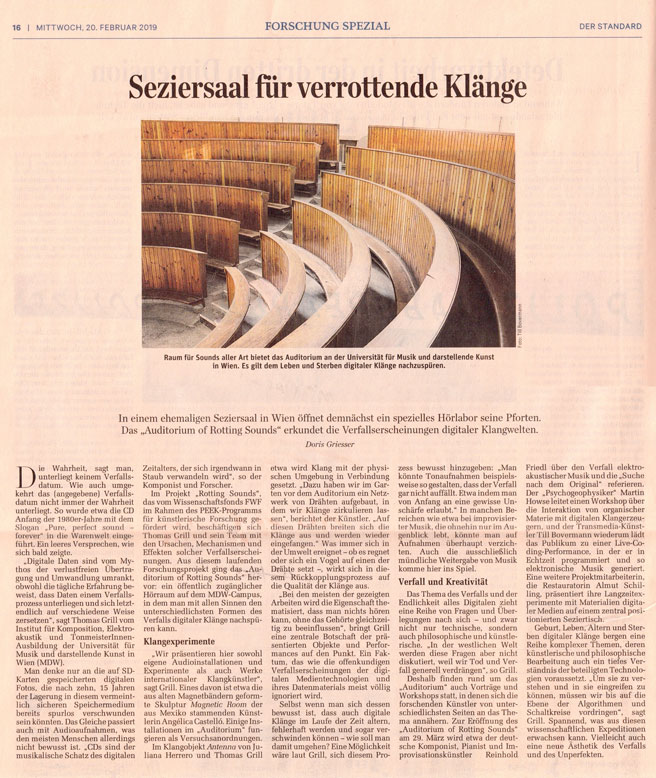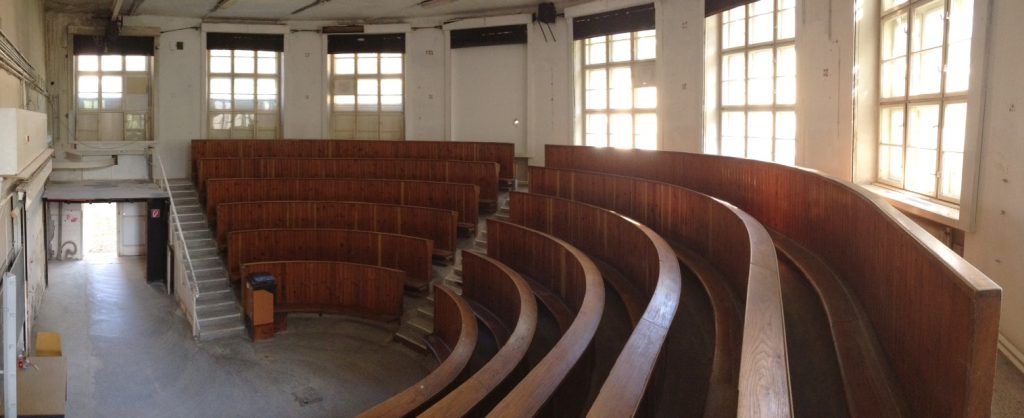Search Results for: auditorium
Intermission
by Mario de Vega, 2019
commissioned by rotting sounds
production by Thomas Grill
Operating System, script, silicon carbide crystal, electric power line
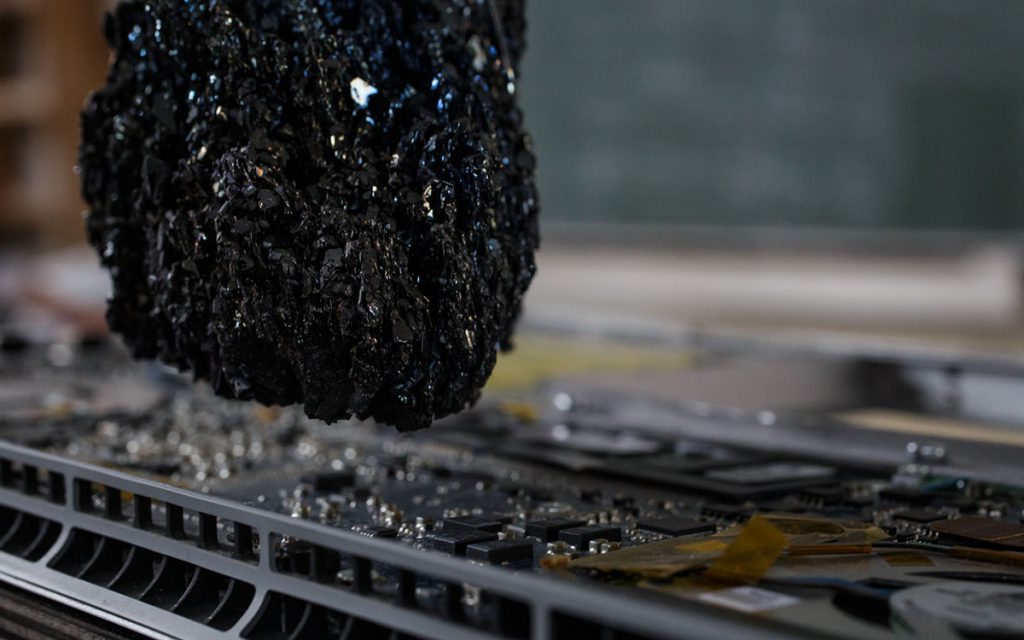
Intermission is composed of an electronic system and a rudimentary suspension mechanism. Its principle is simplified as code written to analyse and retard an audio signal using the microphone input and segments of a computer interface as engines. A piece of silicon carbide crystal, suspended from the ceiling, interacts with the feedback of the system itself, acting as a gate that increases and decreases the fluctuation of a digital signal.
Special thanks to Alberto de Campo and Hugo Esquinca.
Archive
You can find archived sounds of the piece (1 min per hour) at the Rotting Sounds Archive.
Antenna
by Juliana Herrero and Thomas Grill, 2018/19
commissioned by rotting sounds
Steel cable, color, acoustic transducers, digital sound processing, text
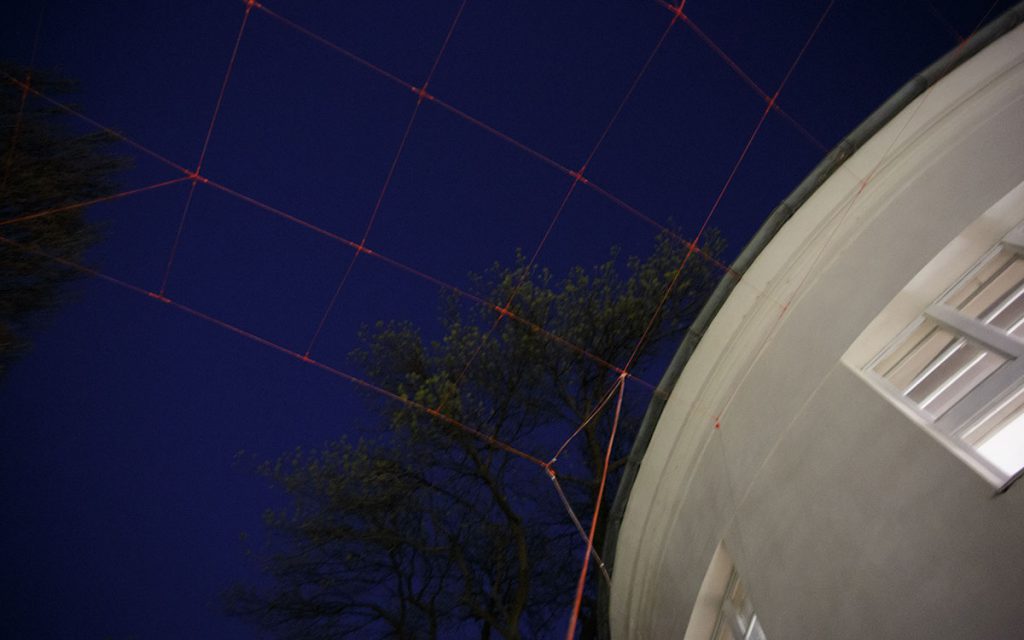
The “Antenna” installation creates an interface between sound and its environment. It transmits sounds generated from encoded text. These acoustic vibrations are resonating through the networked body of the artwork, amplified and broadcasted into the surrounding air. The artwork recites the text of “The Art of Noises” (L’arte dei Rumori), a futurist manifesto written by Luigi Russolo in a 1913 letter to his friend and futurist composer Francesco Balilla Pratella.
An audio codec translates the individual letters into musical chords, which are in turn sent over the wire sculpture. These vibrations are modified within the filigree structure by the environmental conditions — wind, rain, dust, birds sitting on the wire. At the other end of the wire network, the sounds are picked up again and translated back into text. This process can be followed on a small display. By the time, the environment of the sculpture inscribes itself into the text by disturbing single bits of the manifesto, slowly turning it from readable text into environmentally informed noise.
Archive
You can find archived sounds of the piece (1 min per hour) at the Rotting Sounds Archive.
Magnetic Room
by Angélica Castelló, 2017
Woven tapestry made of cassette audios tapes, wooden objects & sound file
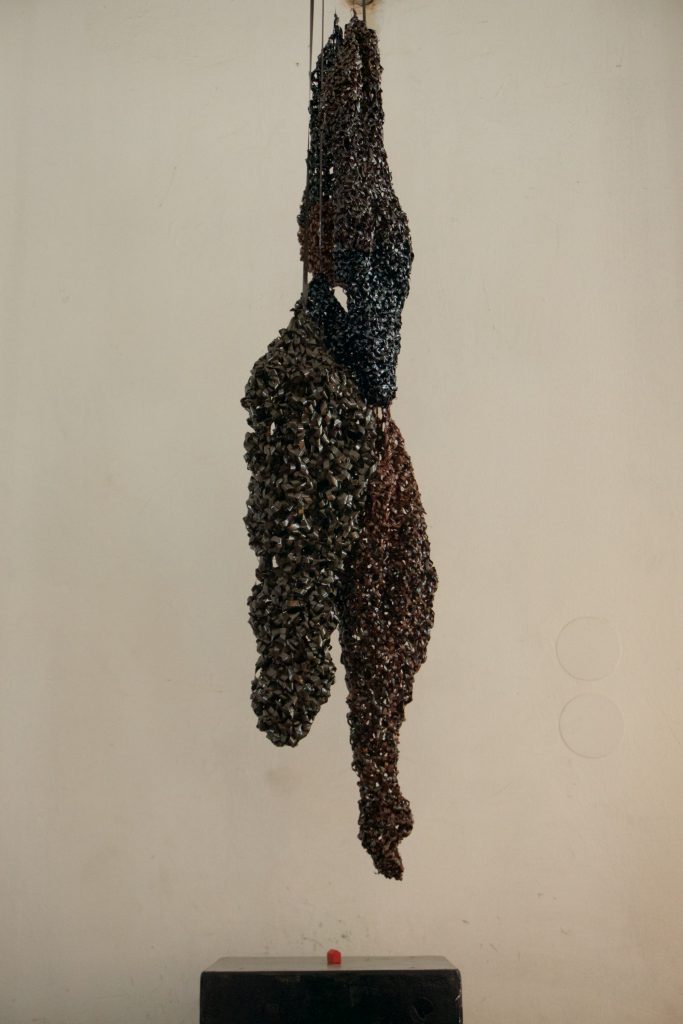
Magnetic Room is a sound installation / composition playing with the ideas of worship, confusion and memory. Intimate LowFi, construction and destruction.
“…I was falling asleep that night I kept thinking about Angélica Castelló’s Magnetic Room. Five amorphous, organ-like shapes made of knit cassette-like tape hang from the ceiling to form one mass of vibrating energy. Even in a dim barn, light inevitably hits the curled tape in thousands of folds, so it glistens like a sweaty reptile just crawling out of a pleasant swamp. A pedestal rests just underneath the floating mass, so as the mass inevitably sways, its movements are amplified by the frame the pedestal provides. A small, red, house-shaped block also rests on the pedestal. Nearby is a cassette player and a pair of headphones. I don’t remember anything about the sounds on the cassette, but the images of the sculpted object presented to my mind an instruction manual for how worry works, how it can be contained, how it can be freed, how it can be darkened, how it can be productive, and maybe even how to think about consuming it.” (Andrew Choate)
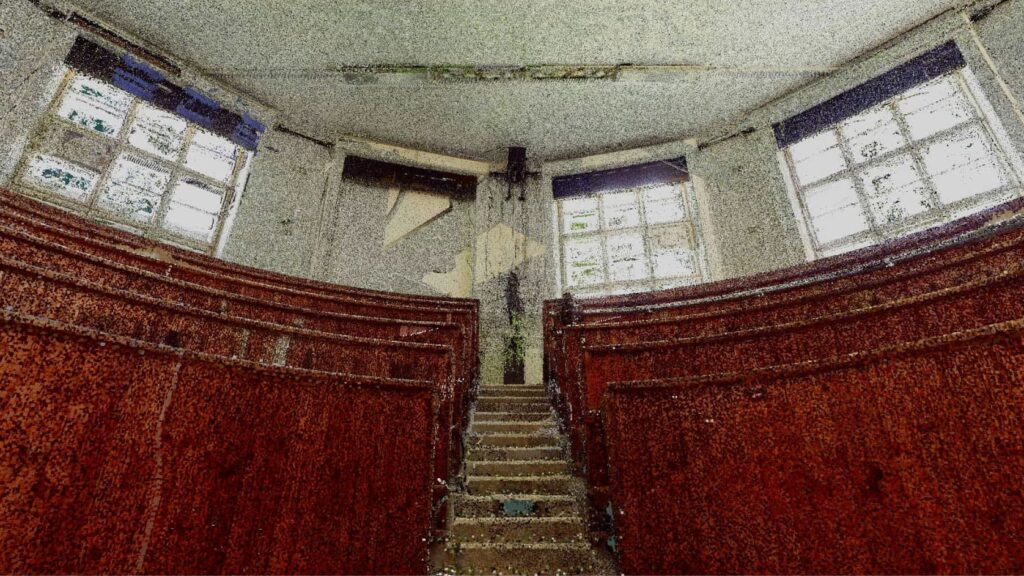
dust a bit
by Klaus Filip and Thomas Grill, 2019–2021
commissioned by rotting sounds
Digital audio via laser beam
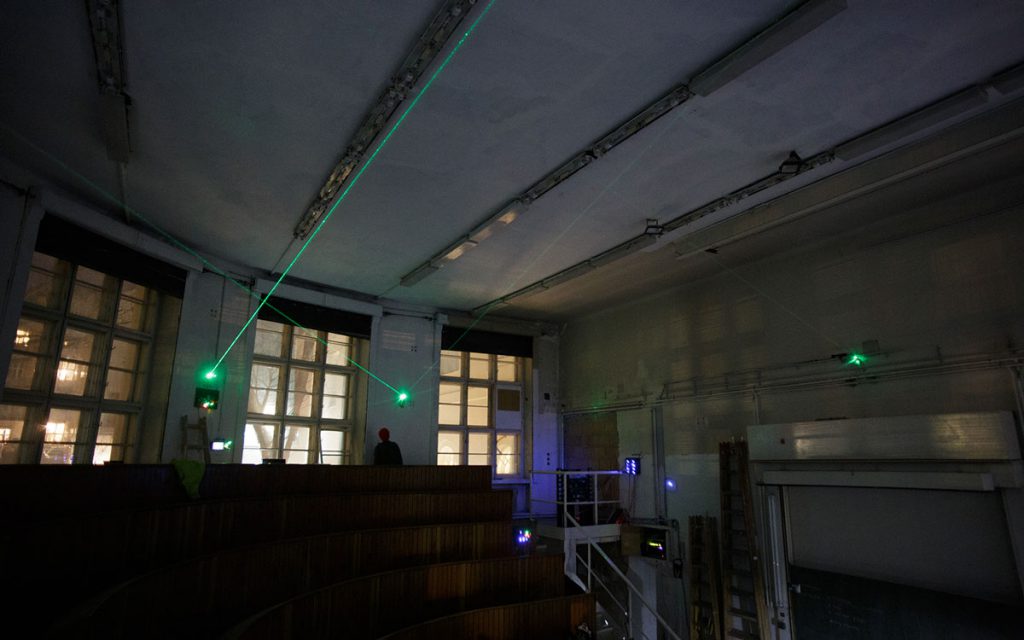
A musical motif in just intonation consisting of pure sine tones serves as starting material. It modulates the intensity of a laser beam. The laser is sent through the room with a mirror several times and finally directed to a phototransistor. On its way through the room, the optical signal is disturbed by the dust present in the air. Individual bits are changed. The dusty bitstream overwrites the memory of the original signal, is sent to the source material and again through the room.
This is repeated over hours, days and months and can be heard via headphones.
Archive
You can find archived sounds of the piece (1 min per hour) at the Rotting Sounds Archive.
CD-R(ot)
by Almut Schilling and Till Bovermann, 2019
CD players, loudspeakers, amplifiers
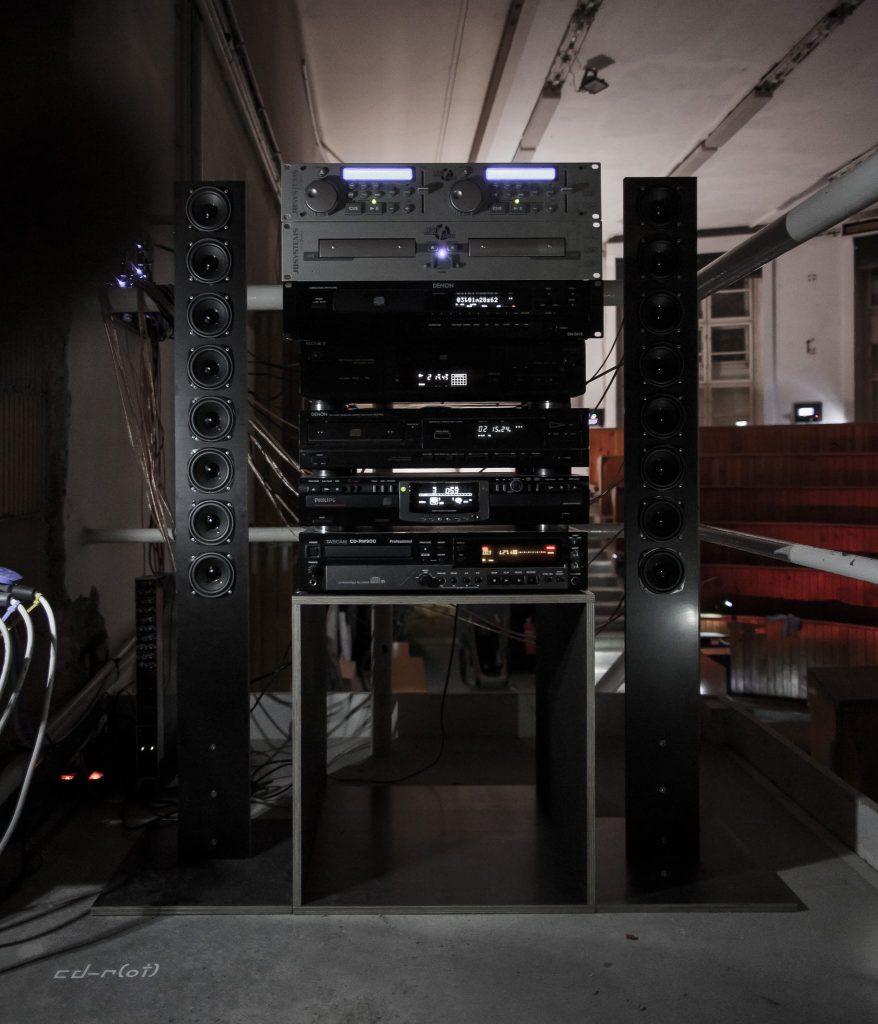
A monolithic CD player stack revealing the (im-)perfections of consumer digital audio. The CD — arguably the first digital music medium for consumers — a “technological breakthrough in audio history reproduction. Laser and disc come together for one of the purest sound ever … a work of magic.” now becomes obsolete.
CD-R(ot) tells about the promise of this “ultimate sound experience by an unbreakable technology”, embodied by CD players and recorders of various brands, quality, and technological generations.
Seven playback machines (8 times 2 channels) are fed with referential material, their analogue output signal identically and simultaneously amplified and emitted. Minimal differences of reproduction emerge, amplifying onto the false promise of “pure perfection” of the digital, the myth that 01010010111 are infinite integrity. Continuous playback causes degradation, amplified by controlled micro-manipulation of the CD material, triggering the very soul of digital reproduction: the error correction.
The result: A pure sound? A mess? A distinct aesthetic of obsolete laser-based technology? Close in onto the perception of this “digital reality” and judge for yourself.
Archive
You can find archived sounds of the piece (1 min per hour) at the Rotting Sounds Archive.
Fields of Haze
by Nicole Krenn and Thomas Grill, 2019
commissioned by rotting sounds
Paint on paper, generative audio composition
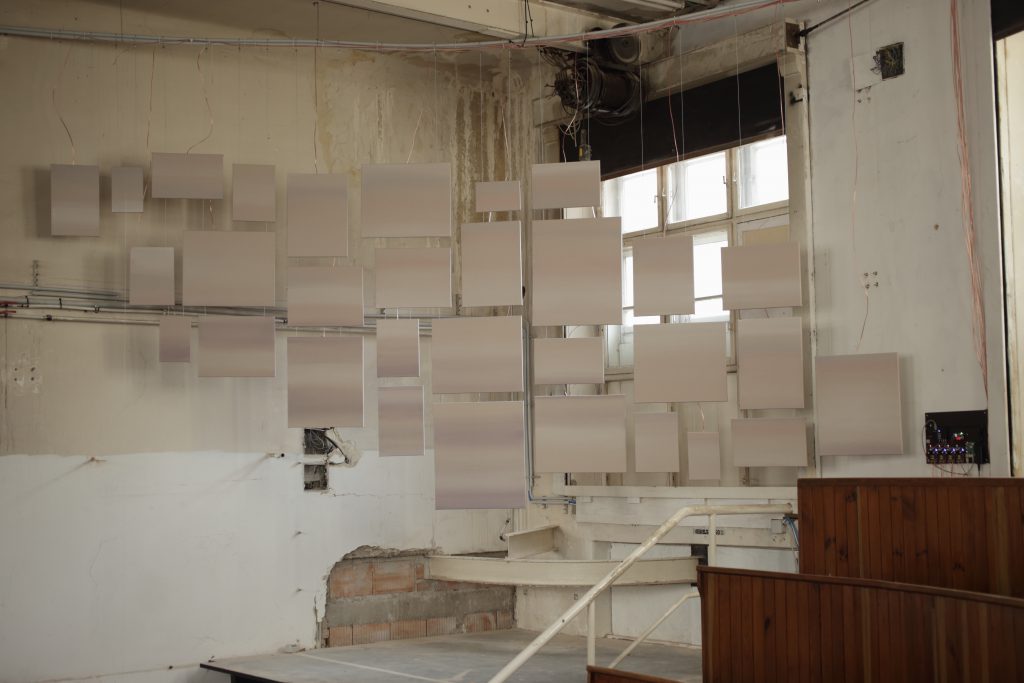
The installation “Fields of Haze” claims the western corner of the auditorium with 31 paper-covered stretcher hangers suspended from the ceiling. The pale color surfaces break the view to the back wall of the library of the Music University – where thousands of scores are stored – on the other side at this point notes for ensembles with several pianos. In very slow succession, chords seep through the wall and emerge through the mists. In short, they are clearly audible, but run quickly and spread out over the paper walls. Gradually, they blend into a vague tonal color that settles permanently in time and space.
Architecturally, the installation presents itself as a flatly dissected image of single images that spans the corner of the room, detached from the classical hanging on a flat wall. Through its permeability, it opens the room into the depth, but on the other hand, it offers a homogeneous radiating surface for the sound. At the same time, the paper carries both a visual and an acoustic color, in a movement that moves both spatially and temporally.
The piano chords represent the composition Véxations by Erik Satie (played by Jaime Wolfson), whose prescribed 840-times repetition at the chosen tempo would take several weeks. The individual sounds melt within a few seconds through spectral erosion processes, as they are also manifested in the MP3 compression and condense into swathes of digital sound vapor.
Archive
You can find archived sounds of the piece (1 min per hour) at the Rotting Sounds Archive.
Article in Austrian daily newspaper Der Standard, February 20
Journalist Doris Griesser has authored a nice feature article on the opening of the upcoming “Auditorium of Rotting sounds” for the Austrian daily newspaper Der Standard.
Spannend, was aus diesen wissenschaftlichen Expeditionen erwachsen kann. Vielleicht auch eine neue Ästhetik des Verfalls und des Unperfekten.
Exploratorium at the MDW campus
Today, we have received the keys to the old abandoned anatomy auditorium located on the campus of the University of Music and Performing Arts Vienna (MDW). This is the last unrenovated part of the whole campus and it will function as a lab and exhibition space for experiments over the course of the whole project. Many thanks to the rector of the MDW for her friendly consent.
Events
- 3.-9. July 2022: Adam McCartney’s and Thomas Grill’s joint composition “rill” will be presented as a piece+paper at the ICMC 2022 conference in Limerick, Ireland
- 14. March 2022: Online presentation of the Research catalogue exposition Fragments in time for the VIS #7 issue by Tobias Leibetseder and Thomas Grill.
- 8. March 2022: Short feature of Rotting sounds in the ORF Ö1 Radiokolleg series
- 11. January 2022: Lecture performance by Thomas Grill at Sweet Spot series, University Mozarteum and Paris Lodron University, Salzburg, Austria.
- 12. November 2021: Adam McCartney’s and Thomas Grill’s joint composition “rill”, part of the festival Wien Modern.
- 11. November 2021: Lecture by Almut Schilling at the Research Day 2021 at the Academy of Fine Arts, Vienna.
- 2. November 2021: Online talk by Thomas Grill at KTH Royal Institute of Technology, Stockhelm, Sweden.
- 8. October 2021: Opening of exhibition “oberhalb/unterhalb” at Stadtgalerie Waidhofen, featuring a fragment of fields of haze.
- 23.+24. September 2021: Rotting Sounds symposium at mdw – University of Music and Performing Arts Vienna.
- 1. May 2021: Opening of exhibition “Rieseln” in National Park Gesäuse‘s visitor’s center in Gstatterboden.
- 24. April 2021: Exhibition “Rieseln” at Nationalparkradio, Radio Freequenns, das Freie Radio im Ennstal.
- 9. April 2021: Presentation of Almut Schilling, Thomas Grill, Till Bovermann: Digital Patina at the SAR2021 artistic research conference.
- 21. March 2021: Voicings of an auralist at ORF Ö1 Kunstradio
- 16. March 2021: Book presentation Knowing in Performing with book chapter Voicings of an auralist
- 18. February 2021: Opening of “Mutual Understanding” at ESC Medienkunstlabor Graz, Austria.
- 17. January 2021: Thomas Grill featuring the installation mutual understanding at Art’s Birthday at Radio Helsinki.
- 1.-2. December 2020: International Faust Conference 2020 with Till Bovermann and Dario Sanfilippo at the Maison des Sciences de l’Homme Paris Nord.
- 26. October 2020: Performance of Low Frequency Orchestra (including Thomas Grill), Jerôme Noetinger and Wolfgang Mitterer @ Reaktor, Wien
- 9. October 2020: Panel discussion with Thomas Grill @ musikprotokoll, Graz.
- 8. October 2020: Performance “noise shaping” by Thomas Grill @ musikprotokoll, Graz.
- 11. September 2020: Performance “merge and dissolve” by Thomas Grill, Till Bovermann and Kathrin Hunze @ SOUND CAMPUS, ars electronica festival, Linz
- 21.-28. August 2020: Residency of Thomas Grill in National Park Gesäuse preparing next year’s exhibition at the visitor’s center in Gstatterboden.
- 20. May 2020: Performance evening at the Auditorium of Rotting Sounds: concert lecture by Stefan Fraunberger – postponed due to the COVID-19 crisis.
- 24. April 2020: Performance evening at the Auditorium of Rotting Sounds: duo Jérôme Noetinger / Thomas Grill – cancelled due to the COVID-19 crisis.
- 19. March 2020: Lecture by Thomas Grill at SAMA, University of the Arts, Helsinki, Finland. – cancelled due to the Corona virus outbreak.
- 17.-20. March 2020: Workshop by Thomas Grill at Aalto University, Department of Media, Helsinki, Finland. – cancelled due to the Corona virus outbreak.
- 6.-7. March 2020: Talk by Almut Schilling at the conference of the Austrian Restoration Association, Salzburg, Austria
- 26. February 2020: Poster presentation at the Klausur der Wissenschaften / MDW.
- 13. February 2020: Performance at Do Trans-Art, Salzburg, Austria.
- 17. January 2020: Rotting sounds @ Art’s Birthday, ORF Radiokulturhaus, Vienna, Austria
- 16. January 2020: Artistic Research Conference “Navigieren im Postdigitalen”. Soundframe @ AIL, Vienna, Austria
- 12. December 2019: Visit of the German Council of Science and Humanities (Wissenschaftsrat) at the Auditorium of Rotting Sounds.
- 4.+5. December 2019: Musical Materialities Panel, Masterclass and Performance at the University of Sussex, Brighton, UK.
- 16.+17. November 2019: Open Studio Days 2019 of the VIENNA ART WEEK. Auditorium open 15-18h.
- 2. October 2019: Performance evening “Fragments” at the Auditorium of Rotting Sounds
- 27. September 2019: Presentation at the European Researcher’s Night, University of Applied Arts Vienna.
- 7. September 2019: Installation “Mutual understanding” at the AI x Music festival, part of the Ars Electronica festival 2019.
- 27. June 2019: Opening of the UNDERSTANDING – ART & RESEARCH exhibition with our participation at the Museum of Applied Arts Vienna.
- 13. June 2019: Musical performance of Thomas Grill and Angélica Castelló at the Cassette Culture Node.Linz exhibition.
- 21.-25. May 2019: Talks, concerts and workshop at the New stage media lab and Herzen University, St.Petersburg, Russia
- 16.-17. May 2019: Mini-symposium on Heretical Sound Synthesis, University of the Arts Helsinki, Sibelius Academy, Helsinki, Finland
- 29. March 2019: Grand opening of the Auditorium of Rotting Sounds, University of Music and Performing Arts, Vienna, Austria.
- 28./29. March 2019: Workshop with Martin Howse and Till Bovermann at the University of Music and Performing Arts, Vienna, Austria.
- 22.–23. March 2019: Participation at the 10th SAR International Conference on Artistic Research at ZHdK, Zürich, Switzerland.
- 13. March 2019: Participation in panel discussion “Ungehörtes – Unerhörtes”, Library of the University of Music and Performing Arts Vienna, Austria.
- 8. December 2018: Participation in the Event Instruments Make Play at WORM, Rotterdam, NL.
- 26.–30. November 2018: Participation in the Orpheus Research Summit in Ghent, Belgium.
- 28./29. November 2018: Talk and artistic intervention at the Forum Media Technology, University of Applied Science in St.Pölten, Austria.
- 8.+9. November 2018: Workshop “sound-material-time”, Anton Bruckner Private University, Linz, Austria.
- 31. October 2018: Performance of the electroacoustic composition residuals at re_composed, part of paraflows XIII, festival for digital art and cultures, Vienna, Austria.
- 8. September 2018: Talk and panel discussion at the symposium “.. under control of Music | Music under control of .. composing (in) digital worlds”, Ars Electronica festival, Anton Bruckner University in Linz, Austria.
- 1.–28. September 2018: Invisible Worlds Residency …and then we will see if we can be friends at Eden Project, Cornwall, UK.
- 14. August 2018: Talk at the isaScience conference in Reichenau/Rax, Austria.
- 8. August 2018: Performance at Silence London, London, UK.
- 16. May 2018: Talk at the Politics of the Machine conference in Copenhagen, Denmark.
- 11. May 2018: Kick-off open session at the University of Music and Performing Arts Vienna, Austria.
- 4. May 2018: Impulse talk at the panel “Artistic research as a bridge between the disciplines”, University of Music and Performing Arts Vienna, Austria.
- 2. May 2018: Talk and discussion at the Angewandte Innovation Lab, Vienna, Austria.
- 4. April 2018: Talk at the Artistic Research symposium, University of Music and Performing Arts Vienna, Austria.
- 27. February 2018: Poster presentation at the science conclave, University of Music and Performing Arts Vienna, Austria.
